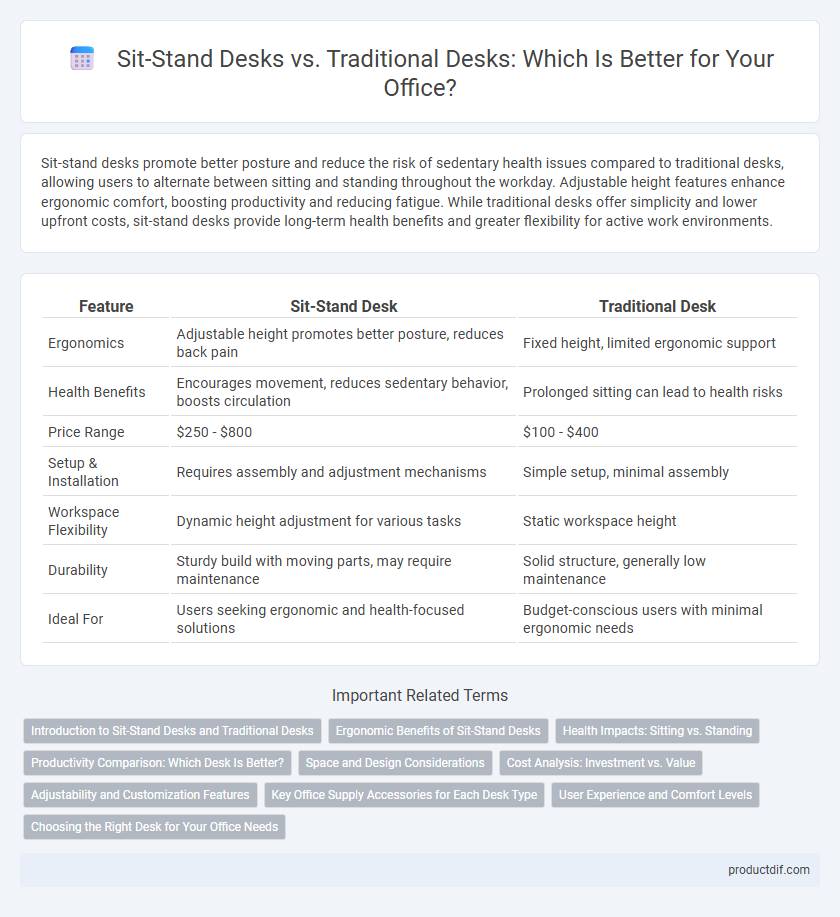Sit-stand desks promote better posture and reduce the risk of sedentary health issues compared to traditional desks, allowing users to alternate between sitting and standing throughout the workday. Adjustable height features enhance ergonomic comfort, boosting productivity and reducing fatigue. While traditional desks offer simplicity and lower upfront costs, sit-stand desks provide long-term health benefits and greater flexibility for active work environments.
Table of Comparison
| Feature | Sit-Stand Desk | Traditional Desk |
|---|---|---|
| Ergonomics | Adjustable height promotes better posture, reduces back pain | Fixed height, limited ergonomic support |
| Health Benefits | Encourages movement, reduces sedentary behavior, boosts circulation | Prolonged sitting can lead to health risks |
| Price Range | $250 - $800 | $100 - $400 |
| Setup & Installation | Requires assembly and adjustment mechanisms | Simple setup, minimal assembly |
| Workspace Flexibility | Dynamic height adjustment for various tasks | Static workspace height |
| Durability | Sturdy build with moving parts, may require maintenance | Solid structure, generally low maintenance |
| Ideal For | Users seeking ergonomic and health-focused solutions | Budget-conscious users with minimal ergonomic needs |
Introduction to Sit-Stand Desks and Traditional Desks
Sit-stand desks offer adjustable height options that promote movement and reduce sedentary time, improving posture and overall health. Traditional desks typically have a fixed height, favoring a seated position that can contribute to discomfort during extended work periods. Ergonomic benefits of sit-stand desks make them a popular choice for modern office environments aiming to enhance employee well-being and productivity.
Ergonomic Benefits of Sit-Stand Desks
Sit-stand desks promote better posture and reduce the risk of musculoskeletal disorders by encouraging frequent movement and variation in working positions. These desks help decrease back pain, neck strain, and repetitive stress injuries commonly associated with prolonged sitting at traditional desks. Incorporating sit-stand desks in office environments enhances employee comfort, productivity, and overall ergonomic health.
Health Impacts: Sitting vs. Standing
Sit-stand desks significantly reduce the health risks associated with prolonged sitting, such as cardiovascular disease and musculoskeletal discomfort. Standing while working promotes better posture, increases energy expenditure, and can decrease the likelihood of developing obesity and type 2 diabetes. In contrast, traditional desks, which encourage extended sitting periods, often contribute to sedentary lifestyles linked to poor circulation and chronic health issues.
Productivity Comparison: Which Desk Is Better?
Sit-stand desks boost productivity by promoting movement, reducing fatigue, and enhancing focus compared to traditional desks, which often lead to prolonged sitting and decreased energy levels. Studies show employees using sit-stand desks report 10-15% higher output and improved cognitive function throughout the day. Ergonomic benefits combined with dynamic postures make sit-stand desks a superior choice for maximizing workplace efficiency and well-being.
Space and Design Considerations
Sit-stand desks offer versatile space-saving designs by integrating adjustable height settings, allowing users to switch between sitting and standing without requiring extra room for additional furniture. Traditional desks often demand more fixed space due to bulky storage compartments and static height, limiting ergonomic flexibility. Modern sit-stand desks enhance office aesthetics with sleek, minimalist designs that accommodate cable management and promote a clutter-free workspace.
Cost Analysis: Investment vs. Value
Sit-stand desks generally require a higher initial investment, ranging from $300 to $1,200 depending on features and brand, compared to traditional desks, which typically cost between $100 and $500. Despite the upfront cost, sit-stand desks offer long-term value through increased productivity, reduced health issues such as back pain, and potential healthcare savings. Evaluating total cost of ownership, including ergonomic benefits and employee well-being, often demonstrates a better return on investment for sit-stand desks over traditional ones.
Adjustability and Customization Features
Sit-stand desks offer superior adjustability compared to traditional desks, allowing users to easily switch between sitting and standing positions to promote ergonomic benefits and reduce sedentary behavior. Customization features such as adjustable height settings, programmable memory presets, and modular add-ons enhance user comfort and productivity, catering to individual work preferences. Traditional desks generally lack these dynamic adjustability options, limiting posture variation and long-term ergonomic support.
Key Office Supply Accessories for Each Desk Type
Sit-stand desks benefit from ergonomic accessories such as adjustable monitor arms, anti-fatigue mats, and cable management solutions that enhance posture and reduce strain during transitions between sitting and standing. Traditional desks commonly utilize keyboard trays, desk organizers, and task lighting to maximize workspace efficiency and maintain proper ergonomics while seated. Both desk types require quality office chairs, wireless charging stations, and document holders to support productivity and comfort throughout the workday.
User Experience and Comfort Levels
Sit-stand desks enhance user experience by promoting better posture and reducing fatigue through adjustable height settings, allowing seamless transitions between sitting and standing positions. Traditional desks often limit movement, potentially causing discomfort and increasing the risk of musculoskeletal issues during prolonged use. Comfort levels with sit-stand desks are typically higher due to ergonomic benefits that support dynamic working habits and personalized workspace configuration.
Choosing the Right Desk for Your Office Needs
Sit-stand desks improve ergonomics by allowing users to alternate between sitting and standing, reducing the risk of musculoskeletal issues and boosting productivity. Traditional desks offer a stable, familiar workspace that suits tasks requiring prolonged sitting or heavy equipment. Selecting the right desk depends on individual work habits, office space, and health considerations to enhance comfort and efficiency.
Sit-Stand Desk vs Traditional Desk Infographic

 productdif.com
productdif.com